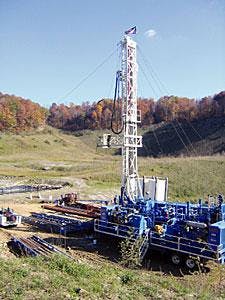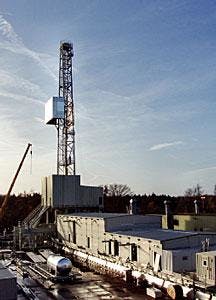The drilling market is buoyed by newly designed rigs but hampered by bottlenecks in manufacturing “smart iron.”
It’s old news that drilling is increasing and day rates are rising, spurring rig building programs throughout the world. Among the hundreds of new builds, however, are a few new designs, which take advantage of technological innovations that improve efficiency, increase safety, and decrease the environmental impact of drilling.
Innovative lightweight, self-erecting structures, modules, AC systems, top drives, automated pipe-handling equipment, more robust mud pumps, advanced solids-handling equipment (including zero-discharge systems), and climate-controlled driller’s cabins with streamlined drilling controls are featured in many of the new rigs. The overall quality and versatility of the drilling fleet is improving.
SCORE reaches 100
GlobalSantaFe Corp.’s summary of current offshore rig economics (SCORE) for December 2005 was up 6.7% from the previous month. The SCORE compares the profitability of current mobile offshore drilling rig day rates to the profitability of day rates at the 1980-81 peak of the offshore drilling cycle (when SCORE = 100).
It took nearly 25 years, but the worldwide SCORE is finally exceeding the 1980-81 benchmark. In December, the worldwide SCORE reached 102.9, and the jack up SCORE reached 102.5, with semisubs at 105.5. The Gulf of Mexico reached 109.4, the North Sea 111.7, West Africa 98.1, and Southeast Asia 72.7.
The SCORE for the Gulf of Mexico, the North Sea, and semisubmersible rigs had already exceeded 100 in the November 2005 report. At the 4.6%/month increase in West Africa, the SCORE for that region will soon exceed 100.
Worldwide SCORE for all regions and rig types is currently increasing at 6.7%/month.
Pressure-control equipment
Three companies supply the majority of blowout preventers (BOPs) for offshore rigs: Hydril Co. LP, Cooper Cameron Corp., and National Oilwell Varco Inc.
On Jan. 12, Houston-based Hydril announced that its capital equipment backlog reached received $157 million as of Dec. 31, 2005. This backlog represents a 257% quarterly increase from $61 million on Sept. 30, and a 1,047% increase from the $15 million order backlog on Dec 31, 2004.
Hydril’s current position results from BOP orders for five jack ups and five deepwater rigs in the last quarter of 2005. This includes multiplex BOP control systems and BOP stacks for deepwater semisubmersibles from A.P. Moller-Maersk AS and others.
Hydril manufactures its own elastomers and metal parts for all of its pressure-control products. The company’s fourth-quarter 2005 financial results were announced Jan. 31, 2006.
In July 2005, Houston-based Cooper Cameron announced a restructuring of its Cameron division, responsible for drilling systems, surface and subsea systems, and chokes and actuators. The Cameron division contributes more than 60% of company revenues, more than the Cooper Cameron Valves and Cooper Compression divisions.
In October, the company reported that overall third-quarter ($636.6 million) and year-to-date ($1.78 billion) revenues reached new records. As of Sept. 30, the Cameron division’s order backlog had reached $1.48 billion, nearly double the $752.9 million backlog in place at the end of 2004, and up 2,288% from the Sept. 30, 2004 backlog of $647.5 million.
Katy, Tex.-based Cameron Elastomer Technology (CET) is responsible for development, manufacturing and testing of all the Cooper Cameron elastomers, including packers, seals, wear pads, and other components.
Pressure-control equipment is only a small part of National Oilwell Varco’s (NOV) overall business, but the company provides a selection of annular, hydraulic, manual, ram, slide-lok, snubbing, subsea, and universal BOPs.
In October 2005, NOV announced third-quarter earnings and order backlog. NOV’s rig technology segment, which includes most of the capital equipment manufactured and sold by the company, had third-quarter 2005 revenues of $572.8 million.
NOV Ideal rigs
In May 2004, National Oilwell announced its new 1,500-hp Ideal rig drilling system designed for the North American land rig market. The rigs were initially marketed at $6.9 million each, with the option to add a BOP, top drive, and drill pipe for less than $2 million additional. The conventional SCR rigs are capable of drilling to 18,000 ft and feature disc brakes, large mud pumps, advanced solids handling equipment, zero-discharge systems, and modern drilling controls. David Crumpler represents NOV’s Ideal rig group.
The most recent order for Ideal rigs was announced in December 2005. Bridgeville, Pa.-based Union Drilling Inc. ordered three Ideal rigs for $24 million, to be delivered in March, May, and June 2006. Union Drilling also purchased an option for $1 million, to purchase three additional Ideal rigs from National-Oilwell LP for $25.2 million, but the option must be exercised by Apr. 30.
Union Drilling had previously purchased a new 900-hp rig from National Oilwell with 440,000-lb hook load capacity and 14,000-ft depth rating (Rig 54).
GEFCO SpeedStar rigs
These rig orders follow Union Drilling’s receipt of two newly constructed GEFCO SpeedStar top drive rigs in November and December, to be used in Southern Appalachian basin coalbed-methane drilling. These 515-hp rigs (Rig 53, Rig 55) have 185,000-lb hook load capacity and can drill to 7,000 ft (Fig. 1).
Union Drilling was the largest privately held land-drilling contractor in the US until its initial public offering of 8.8 million shares of stock in November 2005.
George E. Failing Co., based in Enid, Okla., builds SpeedStar rigs with top drives. The SpeedStar is available with hook-load capacity of 185,000 lb, 150,000 lb, and 40,000 lb. The SS40 has 110,000-lb hook load and 4-5,000 ft drilling depth capacity. GEFCO sales manager Tim Lewis told OGJ that there are more than 100 SS40s operating worldwide, but only a few of them have been sold recently. The market is moving toward the heavier rigs.
Lewis told OGJ that the company has built about seven of the 185,000-lb capacity SpeedStar rigs and about 25 of the older style 150,000-lb rigs, all for the US market. The company recently upgraded the 150,000-lb SpeedStar with better hydraulics and more top head torque and have built about six of the upgraded rigs.
GEFCO built about 6-7 SpeedStars in 2005 and plans to build 13-14 more of the rigs in 2006. The GEFCO yard is booked until 2007. Lewis said that the two larger SpeedStar models sell for $1-1.3 million and the company sees an even split of new and repeat customers.
New Siberian rigs
In January, Abbot Group announced that KCA Deutag had a new contract with TNK-BP Ltd. to build four HR-5000 fit-for-purpose pad-drilling rigs for operations in the Uvat region, Tyumen Oblast, western Siberia. TNK-BP is Russia’s second largest oil company and its major producing assets are located in West Siberia, the Volga-Urals, and East Siberia.
TNK-BP is based in Moscow, 50%-owned by BP, and led by President and CEO Robert Dudley. Tenders are issued only in Russian (http://www.tnk-bp.com/procurement).
Bentec GMBH Drilling & Oilfield Systems, a division of the Aberdeen-based Abbot Group, designed the new “cluster slider” rigs (Fig. 2). The HR-5000 is a fully winterized 1,500-hp drilling system intended for extreme conditions. The skidding system includes hot air blowers on the rail track and the support system block. The derrick has a 350-tonne hook load capacity.
Ancillary equipment, including mud-separation systems, tank systems, mud pumps, air compressors and heating system are erected on trolleys that move with the mast and substructure. The rig can move within a 40-km radius in 18 days, depending on weather and road conditions.
The company says that the rig was built in compliance with Russian rules and regulations, in particular those of Gosstandart (GOST), the national standardization body of Russia, and the rules of the Russian mining authority, Rosgortekhnadzor.
Bentec produced the mast, substructure, crown, and traveling blocks. The GH1500 EG-DC drawworks are from Wirth GMBH, incorporating Bentec’s FOCS automatic driller and brake cooling systems. Kaeser GMBH provided the ASD 37 screw-type compressor system. The hydraulic power unit, which serves both the rig’s skidding system and the drilling equipment, is from Bentec and Niehues GMBH.
In October 2005, KCA Deutag opened its new Russian head office in Tyumen, western Siberia. The company has a 4-year contract (2004-08) with Salym Petroleum Development NV, a 50-50 joint venture between Shell and OAO Evikhon, to provide development-drilling services. KCA Deutag commissioned two new BU-3900 series Arctic drilling rigs for the contract.
KCA Deutag was also operating the 2,000-hp T-2000 rig in western Siberia. The rig was used by Schlumberger and RITEK in the Nadym area and drilled horizontal wells in the Nojabrsk district for Sibneft. It’s currently under contract with independent Urals Energy Public Co. Ltd., drilling in Sakhalin.
KCA Deutag already has 8 rigs operating in Russia and will reach 12 with the new HR-5000 contract with TNK-BP.
Nabors PACE rigs
Houston-based Nabors Industries Ltd. owns and operates nearly 600 land drilling rigs worldwide. The company’s new programmable AC electric (PACE) rigs utilize state of the art drilling technology for the newest generation of deep drilling land rigs.
Nabors Drilling International built two of the new rigs (Rig 54 and Rig 200) at the Lamprell facility in Jafza, UAE (Jebel Ali Free Zone). The rigs feature 3,000-hp A/C drawworks, three 1,600-hp pumps, and 7,500-psi mud circulation systems. The driller’s control center is air-conditioned and all systems can be operated with a joystick and touch screens.
The rigs were initially at work on 6-month contracts. Rig 54 was at work in Sabine Pass in the Gulf of Mexico when Hurricane Rita blew its mast over. Nabors was able to install a substitute mast. Rig 54 and Rig 200 are both now drilling in UAE (Fig. 3).
Technical details of the PACE rigs will be featured in an upcoming issue of OGJ.
Upgrading the Q4000
Houston-based Cal Dive International Inc. intends to spend $30 million to add a modular drilling system to the Q4000 deepwater well-intervention vessel. The Q4000 is a column stabilized, twin-hull semisubmersible that first attracted industry attention with its girder beam multipurpose tower (MPT), a 600-ton capacity structure adjacent to the moon pool.
Cal Dive’s Well Ops Inc. subsidiary also deployed a new open-water intervention riser system on the vessel in third-quarter 2003. The Q4000’s 65⁄8-in. riser pipe is the largest diameter available in the Gulf of Mexico; other systems are 4-in diameter.
The new drilling system will incorporate hybrid slimbore technology, designed to access deepwater reservoirs, and will be capable to drilling to 6,000 ft. Some of the necessary components such as the BOP have long lead times and will not be available until 2007.
Raymond James analyst John Freeman suggested that this “should help solve drilling cost and rig procurement problems that made former partner Norsk Hydro USA Oil and Gas Inc., walk away from the Telemark project” in the Gulf of Mexico’s Atwater Valley Block 63.
Norsk Hydro is operator and controls 70%; Energy Resource Technology Inc., a wholly owned subsidiary of Cal Dive, controls 30%. The Telemark field is in 4,300 ft of water. In December, Owen Kratz, Cal Dive chairman and CEO, said, “ERT intends to take up the designation of operator and present the MMS with a new development plan.”
Long-term growth
Richard J. Mason, publisher of The Land Rig newsletter, recently said that the land drilling industry has entered a long-term growth phase. He characterizes the activity in 2005 as following two major themes:
• Capacity constraints-day rates rose rapidly above replacement cost, stimulating an increase in newbuild programs.
• Reactivating old equipment-inventory scattered across the country was dusted off, upgraded, and brought back into service. Mason sees this source of drilling hardware drying up sometime in 2006, followed by an increased deployment of newbuild equipment.
Although dozens of newly built land rigs will reach the US market in 2006-07, manufacturing backlogs for key components such as pressure control equipment and other “smart iron” may create bottlenecks in the supply of new rigs for land and offshore. ✦




